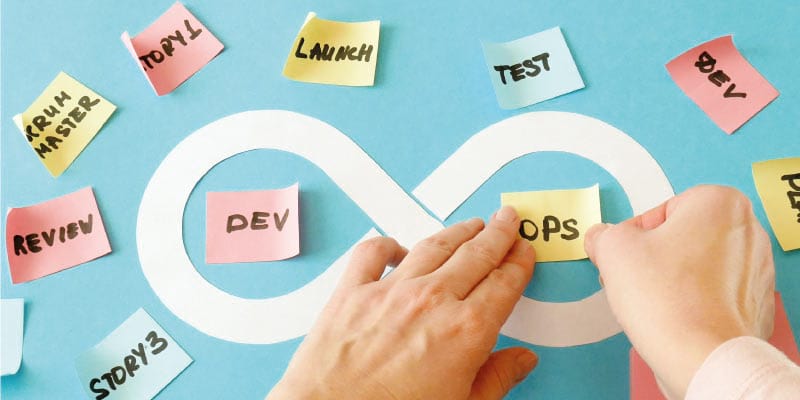Agile Method of Software Development

Agile Method: This article explains the Agile Method in a practical way. Next to what it is (definition and origin), this article also highlights the Agile manifest and core values, the 12 principles, it’s relationship with Kanban, Scrum, DevOps and the Waterfall Method and the core aspects opf Agile leadership. After reading you will understand the basics of this powerful information technology method. Enjoy reading!
What is Agile Method of software development?
The Agile Method, agile methodology or agile project management is an iterative approach to project management and software development. The term agile means resilient, or skillful, and is also used to indicate a way of working that is flexible or agile.
Agile helps companies and teams to work on value for the customer faster and with less hassle.
Agile teams work in small and manageable steps, called iterations. Product owner requirements, schedules and results are constantly evaluated and the small teams can anticipate them quickly.
Additionally, the iterative evaluation process extends beyond functional aspects, encompassing creative elements such as logo design, ensuring a holistic approach to refining and enhancing the overall product.
It is a comprehensive concept and is associated with many methods and topics. Some key concepts related to this are briefly explained later in this article. Click on the appropriate links for more information on the topic.
Origin
Iterative software development methods can be traced back to the early 1970s. It was not until the 1990s that a number of methods evolved in response to the most common criticisms. The methods were described as over-regulated, planned and managed at the micro level.
From then on, lightweight methods were introduced, such as the Rapid Application Development (RAD), Unified Process (UP) and Dynamic Systems Development Method (DSDM).
These methods were all introduced before the Agile manifesto was written, yet they are collectively referred to as agile methods.
Agile manifest
The Manifesto for Agile Software Development is a document that describes the 4 values and 12 principles . It serves as a statement to improve traditional software development methods and responds directly to the inefficiency of these old processes.
The Manifesto was developed by 17 leading software developers in 2001, including Kent Beck (Extreme Programming), Jeff Sutherland (Scrum), and 15 others.
The four values that are central to the this method are:
- Individuals and interaction are more important than processes and tools
- Working software is more important than extensive documentation
- Customer collaboration is more important than contract negotiations
- Responding to change is more important than following a plan
Agile Method principles
The 12 agile method principles are:
- The highest priority is to satisfy the customer through fast and continuous delivery of good software and product development.
- Welcome changing requirements, even late in the development phase. Agile is able to leverage change to create value for the customer.
- Deliver continuous working software in time blocks from a few weeks to a few months, with a preference for weeks.
- During the project, clients and developers must work together and be in contact on a daily basis.
- Give responsibility to motivated individuals within cross functional teams. Give them what they need and trust them to get the job done.
- A personal conversation should always be preferred to transfer information in an efficient and effective way.
- Working software is the most important indicator of progress.
- Processes promote sustainable development if sponsors, developers and users are able to keep up with the pace.
- Constant focus on engineering excellence and good design increases agility.
- Simplicity is key.
- The best architectures, requirements and designs come from self-driven teams.
- The team should periodically reflect on how to become more effective.
Scrum
The Scrum method is a framework for developing, delivering and maintaining products in a complex and rapidly changing environment. While the Scrum method was initially only used for software development, it is being used in more and more areas, including marketing, purchasing, sales, research, and technology.
It is developed for teams with less than ten members who divide their project according to the principles of this Method. These iterations are called sprints.
The Scrum team, lead by a Scrum Master performs these sprints in a period of usually two weeks, no longer than a month. The team meets daily and discusses progress and possible adjustments in the daily stand up meeting.
What is Kanban in relation to Agile?
The Kanban system is a LEAN manufacturing planning system. The method was developed by Taiichi Ohno, industrial engineer at Toyota. It was developed to improve production efficiency.
The Kanban system became an effective tool in supporting production systems as a whole as it aims to avoid waste and errors. Problem areas within the production process are highlighted by measuring and assessing lead time, cycle time and other KPIs.
Another important goal of a Kanban system is to limit the build-up of excess inventory.
This applies to every point in the production process. Limits are set on the number of items waiting for delivery points and are reduced as inefficiencies are identified. That means that every time a limit is exceeded, an inefficiency has to be addressed.
DevOps
DevOps is a development model in which operations teams and development teams are no longer separated. The two are sometimes merged into 1 team, in which the technicians and engineers work together throughout the lifecycle of a project, from the initial development phase to the test phase. In doing so, they develop capacities and skills that are not limited to their own function.
Agile Method and Waterfall Method
The waterfall method is a sequential development process, which runs through all phases like a waterfall. Each phase must be fully completed before the next phase can be started.
One difference between this method and the waterfall method is the approach to quality and testing.
The waterfall model proceeds from phase to phase. The test phase is therefore isolated from the rest and starts after the construction phase.
In an Agile development process, testing is done at the end of each iteration. Because every piece of code or piece of software is tested at the end of the iteration, the customer can already use this new piece of value. This is important for its validation.
If the end user already knows the real value of the piece of software, they can make better decisions about the course of the remaining software package. This process is therefore very similar to the Plan-Do-Check-Act cycle (PDCA).
This method therefore supports a product mindset, instead of a focus on the process. This provides more flexibility during the development process.
By using the iterations, software can be developed, for example in response to interim events in the market.
Agile Method and Agile leadership
The Agile leadership style is a leadership style that strives to remove obstacles on the road to success as much as possible and to create a climate in which employees can be effective and productive.
These teams collaborate more effectively than non-agile teams, so agile leadership drives better business outcomes, in part through reduced waste of time and other resources.
Business agility is an important recurring element in the business world.
By applying concepts from the agile world, companies can switch better and faster to internal and external factors that change.
Traditional organizations and leaders are susceptible to bureaucracy, something that is completely incompatible with the agile mindset. In a bureaucracy, the important decisions are always made at the top, so change can never be reacted quickly.
To support this all, Agile provides the Crystal Method to help traditional management styles in combination with the priorities within team communication, interactions, skills, and talents over processes and tools.
Agile Method: tore Aspects of Agile Leadership
There are three core aspects of Agile leadership. These are explained below.
Transparent communication
Agile leaders communicate openly and are completely transparent with the members of their team. The top priority of these leaders is to remove obstacles for the team members so that they can achieve their goals effectively and quickly.
By communicating effectively about these obstacles and progress, these leaders can anticipate the barriers to success and remove them in time.
Observe and listen
These leaders always observe and listen carefully to the team members. When a problem is identified, the agile leaders collect the necessary input from the executives to enable better processes and innovate where possible. Listening to employees who also share user stories is the key to success in leadership.
These leaders understand that practical solutions to problems within certain processes are likely to come from the people who work with those processes.
Understanding external environment and forces
These leaders don’t just look at their teams. They also constantly look at the external environment of the team i.e user experience (UX) and user stories. They understand how changes in the market, economy or demographics affect the workplace. They continuously adjust their strategic priorities accordingly.
The result of having these leaders within an organization is that companies can quickly adapt to the world. They are constantly discovering more ways to improve the performance of their employees.
Now It’s Your Turn
What do you think? Do you recognize the explanation about the Agile Method? Do you apply this working method in your work environment? Which methods do you know? Do you think an agile way of working is more effective when it comes to creating value for the customer? Do you have any tips or comments?
Share your experience and knowledge in the comments box below.
More information
- Abrahamsson, P., Salo, O., Ronkainen, J., & Warsta, J. (2017). Agile software development methods: Review and analysis. arXiv preprint arXiv:1709.08439.
- Dybå, T., & Dingsøyr, T. (2008). Empirical studies of agile software development: A systematic review. Information and software technology, 50(9-10), 833-859.
- Szalvay, V. (2004). An introduction to agile software development. Danube technologies, 3.
- Parker, D. W., Holesgrove, M., & Pathak, R. (2015). Improving productivity with self-organised teams and agile leadership. International Journal of Productivity and Performance Management.
How to cite this article:
Janse, B. (2022). Agile Method of Software Development. Retrieved [insert date] from Toolshero: https://www.toolshero.com/information-technology/agile-method/
Original publication date: 07/03/2022 | Last update: 04/19/2024
Add a link to this page on your website:
<a href=”https://www.toolshero.com/information-technology/agile-method/”>Toolshero: Agile Method of Software Development</a>













One response to “Agile Method of Software Development”
Thanks for the valuable experience